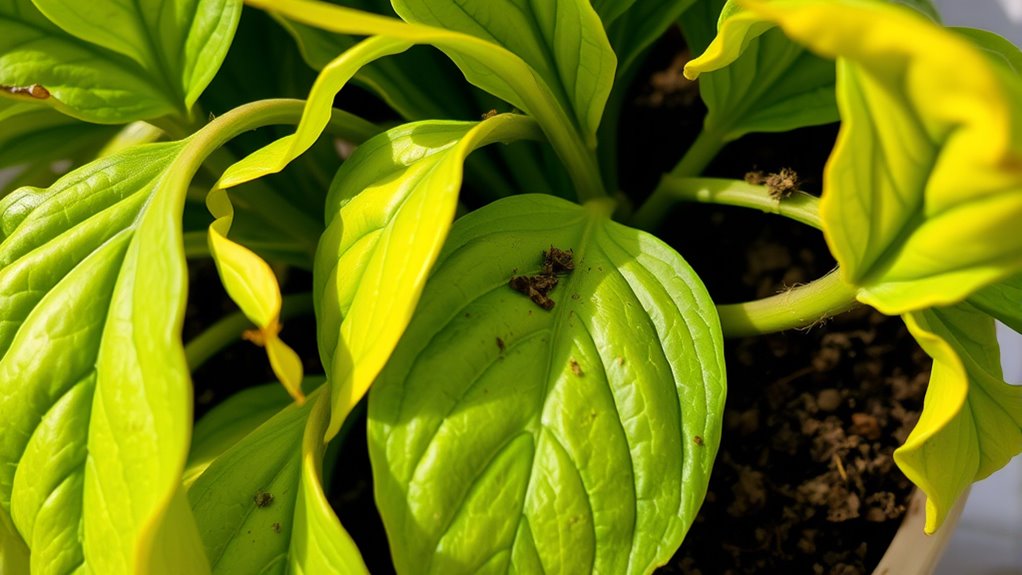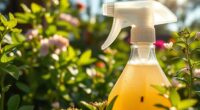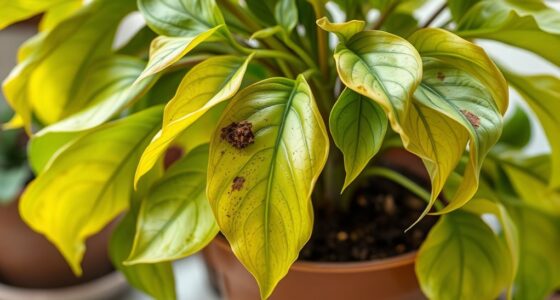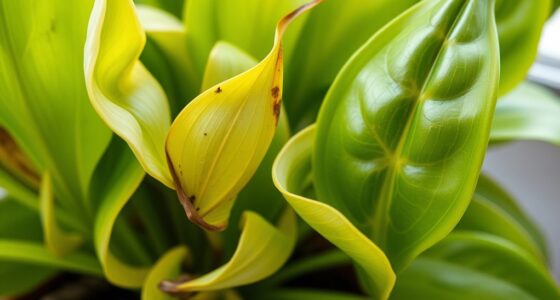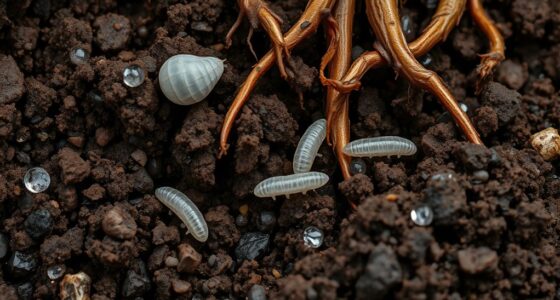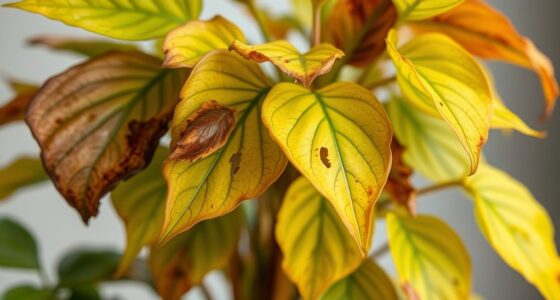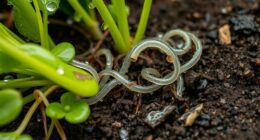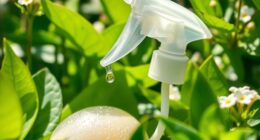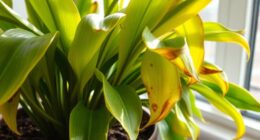If your plant shows yellowing leaves, droops, or feels soggy or dry, it’s likely an watering problem. Webbing or sticky residue might mean pests like aphids or mealybugs are present. Browning leaf edges or spots could indicate low humidity or nutrient issues, while curled or distorted leaves often signal environmental stress. Spotting these signs early helps diagnose problems quickly. Keep an eye out for more clues and solutions as you explore common plant issues further.
Key Takeaways
- Observe leaf color and texture for signs of overwatering, underwatering, or pests.
- Check soil moisture levels regularly to prevent root rot or dehydration.
- Look for pests like aphids, spider mites, or mealybugs on undersides of leaves and foliage.
- Monitor environmental factors such as air circulation and humidity to avoid stress-related damage.
- Note unusual symptoms like spots, discoloration, or deformities to identify disease or nutrient deficiencies.
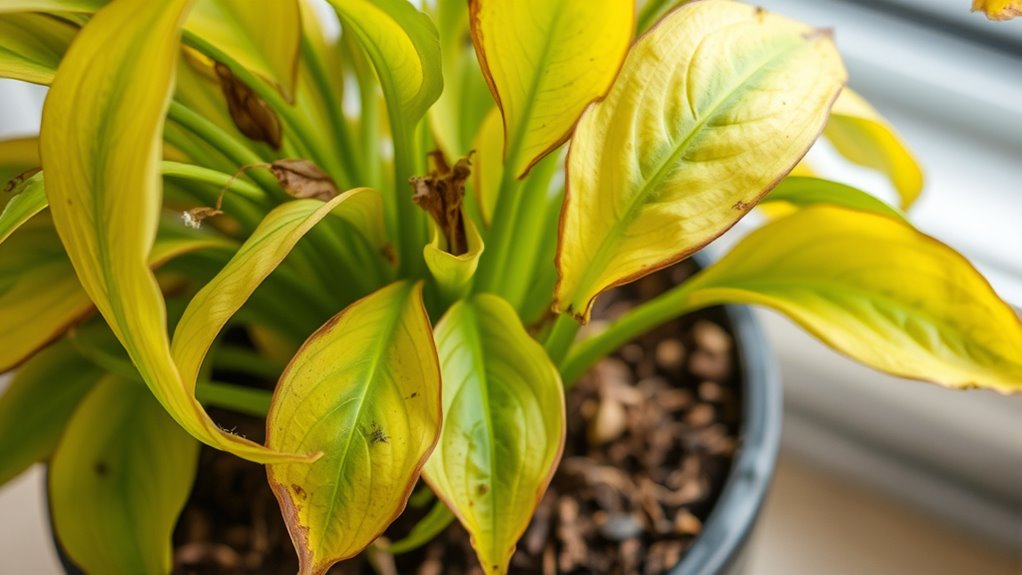
Plants can develop a variety of issues that affect their health and growth, but many problems are easy to identify once you know what to look for. One of the first areas to inspect is watering issues. Overwatering can cause leaves to yellow and drop, roots to rot, and soil to remain soggy for too long. Conversely, underwatering leads to wilting, dry or crispy leaves, and stunted growth. To diagnose watering problems, check the moisture level of the soil with your finger or a moisture meter. If the soil feels excessively wet and your plant’s leaves are yellowing, it’s likely overwatered. If the soil is bone dry and the plant looks droopy, underwatering is the culprit. Adjust your watering schedule accordingly—allow the top inch of soil to dry out before watering again, and ensure your pot has proper drainage to prevent water from pooling. Regularly monitoring your plant’s environment can also help identify other stressors early. Beyond watering issues, pest identification plays a crucial role in diagnosing plant health problems. Pests are often sneaky; they hide on the undersides of leaves or within the foliage, making them easy to overlook at first glance. Common pests like aphids, spider mites, and mealybugs leave telltale signs that you can spot early. Look for small insects, sticky residue, webbing, or distorted leaves. For instance, aphids cluster on new growth and suck plant sap, causing leaves to curl or yellow. Spider mites produce fine webbing and stippling on leaves. Mealybugs look like white cottony patches. Regularly inspecting your plant helps catch these pests early, preventing a minor infestation from becoming severe. If you spot pests, promptly isolate the plant to prevent spread and treat with insecticidal soap or neem oil. Removing pests early can save your plant from further damage and potential death. Additionally, understanding the role of air quality and environmental factors can aid in diagnosing issues, as poor air circulation or dry air can cause leaf edges to brown or drop. In addition to watering issues and pests, keep an eye out for other signs like leaf spots, discoloration, or unusual growth patterns. Each symptom can point to a specific problem, whether it’s nutrient deficiency, disease, or environmental stress. By paying close attention and diagnosing issues early, you can take targeted action to help your plant recover. Regularly monitoring your plant’s condition, understanding common symptoms, and knowing how to identify pests are vital steps in maintaining healthy, thriving plants. Remember, most problems are manageable once you recognize the warning signs and respond quickly.
Frequently Asked Questions
How Often Should I Water My Plant During Winter?
During winter, your plant’s watering schedule needs adjustment for proper winter care. You should water less frequently, typically once every 2-3 weeks, depending on the plant type and indoor conditions. Always check the soil moisture before watering—if the top inch feels dry, it’s time to water. Avoid overwatering, as winter’s lower temperatures slow evaporation, risking root rot. Proper winter care keeps your plant healthy and thriving through the colder months.
Can Over-Fertilizing Harm My Plant?
Over-fertilizing can definitely harm your plant. When you give too much fertilizer, it causes a fertilizer overdose, which can lead to nutrient toxicity. This stresses your plant, causing yellowing leaves, root damage, or stunted growth. Always follow the recommended amount and frequency. If you notice symptoms of nutrient toxicity, flush the soil with water to remove excess nutrients and help your plant recover.
What Pest Signs Indicate a Plant Infestation?
You can spot a plant infestation by looking for pest signs like tiny holes in leaves, sticky residue, or webbing. Pest identification helps you understand which pests are causing trouble. Watch for infestation symptoms such as discolored or deformed leaves, and presence of insects or eggs. Regularly inspecting your plant guarantees you catch issues early, making pest control easier and more effective.
How Do I Improve Soil Drainage for My Plant?
When tackling soil drainage issues, you’re hitting two birds with one stone. First, improve drainage solutions by mixing in soil amendments like sand, perlite, or organic compost to loosen heavy soil. These additions help excess water escape faster, preventing root rot. Remember, a well-draining soil setup keeps your plant happy and healthy, so regularly check and adjust your amendments as needed to maintain ideal drainage and avoid waterlogged roots.
Are There Natural Remedies for Plant Diseases?
You can use natural remedies to treat plant diseases effectively. Organic treatments like neem oil, compost teas, and garlic spray act as homemade remedies that boost plant health and fight off infections. These options are eco-friendly and safe for your plants, helping to control issues without harsh chemicals. Regular application and early detection are key, so keep an eye on symptoms and apply these natural solutions promptly for best results.
Conclusion
Think of your plant as a delicate dance partner, and every sign of trouble as a whispered warning. When you listen closely and respond with care, you help it find its rhythm again. Just like tending a wounded bird, your attentive touch can restore its strength and beauty. Remember, your plant’s health mirrors your patience and love—nurture it well, and it’ll thrive, turning your home into a lush, vibrant sanctuary.
